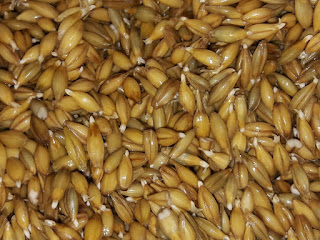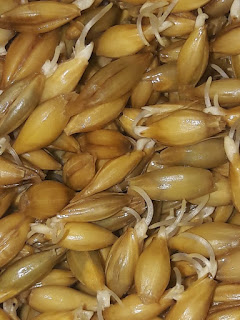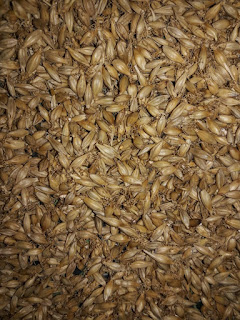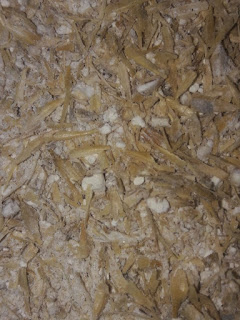I have been an enthusiastic beer drinker for sometime now and have often wondered how hard it would be to make beer at home. The data is all very scary. All sources warn of dire consequences including going blind because methanol, and dying because enterococcus infection.
But humans have been brewing and drinking beer for at least 10,000 years so I'm pretty sure most of these terrifying tales, while based in scientific facts, are hyped out of proportion.
So anyway, in May 2018 I went ahead and bought a bag of un-hulled barley and a kitchen Thermometer on Amazon
And promptly forgot all about it.
One of my resolutions for 2019 is to finish all my unfinished projects.
18 January 2019, 20:00
And so on 18 January 2019 I soaked the barley in a big pot of water for 12 hours. After 12 hours I drained all the water and kept the pot covered in warm dark place (our kitchen cupboard).
19 January 2019, 19:00
23 hours later...Chitting! This is the start of the germination of the grain.
20 January 2019, 08:00
After 36 hours, it looks like pretty much every one of my barley foster babies is well on the way to germinating.
Looks like my procrastination actually helped. Not all the seeds in a batch will always germinate at once. This is because of an evolutionary strategy called seed dormancy.
Those little white structures would eventually turn into the root of the barley plant
This is probably as good a time as any to talk a little about the bio-chemistry of beer making.
The alcohol in the beer, is produced as a by product of yeast ingesting simple sugars.
The grain, such as barley doesn't have sugars to begin with. What it does have are complex sugars and starch. Fortunately, when germinating, the grain produces enzymes, which can break down these complex sugars into simple sugars.
20 January 2019, 17:00
After 45 hours, the rootlets are well formed and the acrospire is beginning to emerge.
The acrospire is the structure that I have circled. The acrospire would eventually have grown into the shoots of the plant. Of course we'll not let it get that far.
21 January 2019, 17:00
After 69 hours, the acrospire length is at approximately 60% of the grain length. When it reaches 80-100% of the grain length, the enzyme content will be at a maximum and it will be time to dehydrate these guys.
I should mention that through out the germination period, I gently agitated the pot with the grains every 6-8 hours. This is because;
1. While the warm wet conditions are ideal for germination, they are also ideal for that big enemy of the brewer - mold
2. The grains on the top tend to dry up faster that the ones at the bottom of the pot. Gentle agitation evenly distributes the moisture. I also added water as required
3. These germinating grains give off quite a bit of heat! the agitation aerates and cools them down.
22 January 2019, 07:00
83 hours... almost there
22 January 2019, 17:30
93.5 hours...it is time
23 January 2019, 18:00
24 hour into the dehydrating process...called kilning
For the first 12 hours, I dried these grains under the fan to avoid the thermal shock and later under the sunlight, covered with a piece of cloth.
24 January 2019, 18:00
After 48 hours of kilning, the grains are now super dry and crunchy
26 January 2019, 12:00
Now I have to remove the rootlets from the grain, a process called "debearding". I had read that the rootlets cause unpleasant tastes in the final product and was keen to get rid of them.
This proved to be a little bit more challenging than I expected. I tried various strategies including putting the grains in a box and shaking them about;
but I only managed to break loose a few of the rootlets;
28 January 2019, 17:00
I thought maybe dehydrating the further artificially would help, so I put them in the microwave on the convection program with the temperature set to 40 degrees C.
but it didn't.
31 January 2019, 17:30
Debearding had me stumped for almost whole week, before one day, (when the wife was not at home!)
The kneading attachment on the food processor worked like a charm. In less than a minute all the grains were debearded
All that remained was to sift them through a soup strainer
Here are the amputated rootlets;
2 February 2019 15:30
I now had to break the grains up, to expose the endosperm, so that the enzymes could digest them much more easily.
I took the easy route and whipped them in the food processor. I probably shouldn't have done that, because they got ground bit finer than I wanted. This would lead to suspended particles in my beer.
There are quite a number of enzymes in the grain and they each digest a different complex sugar molecule. Each of these enzymes work best at a certain temperature.
The next process is called mashing; the broken grains are mixed with water and raised to a certain temperature and held there for 20 minutes. These are called "enzyme rests". These enzyme rests provide enough time for each enzyme to work on the respective complex sugar.
I'm pretty sure I can't trust the readings on this cheap Chinese Thermometer, but for whatever it's worth...
I'm pretty sure I can't trust the readings on this cheap Chinese Thermometer, but for whatever it's worth...
I gave it four enzyme rests of 20 minutes each, at 45, 50, 60 and 70 degrees C. I must have done it right because by the 4th rest, the mash was SWEET
After the rests, I took the temperature up to 80 degrees C (Mash out) to stopping the enzyme action before filtering the mash.
I was left with a sweet cloudy liquid, called "Wort"
I was left with a sweet cloudy liquid, called "Wort"
The next stage, "the boil" achieves a number of objectives;
1. Sanitizing the wort
2. Stabilizing the protein content
3. Denaturing all the enzymes
I held the wort at a rolling boil for 60 minutes;
2 February 2019, 20:30
After the wort had cooled down, I "Pitched" in a pre-hydrated solution of yeast;
1. Sanitizing the wort
2. Stabilizing the protein content
3. Denaturing all the enzymes
I held the wort at a rolling boil for 60 minutes;
2 February 2019, 20:30
After the wort had cooled down, I "Pitched" in a pre-hydrated solution of yeast;
3 February 2019, 05:30
3 February 2019, 07:40
Although the fermentation was incomplete, I couldn't take the suspense anymore...I tried half a glass;
Although the fermentation was incomplete, I couldn't take the suspense anymore...I tried half a glass;
It was like nothing I'd had before. The closest would probably be fresh palm toddy.
It was sweet with a malty aftertaste, like Bournvita. It was also quite dense, because of all the suspended barley
It had a very slight fizz and was very refreshing.
Not having added hops, a known anti-microbial agent, and also not having the ability to maintain a very antiseptic environment in my kitchen, I decided to drink the whole thing that afternoon.
I called over some friends too;
Overall the feedback wasn't too bad.
What would I do differently next time?
1. Not crush the grain quite so fine
2. Let it ferment for longer
It was sweet with a malty aftertaste, like Bournvita. It was also quite dense, because of all the suspended barley
It had a very slight fizz and was very refreshing.
Not having added hops, a known anti-microbial agent, and also not having the ability to maintain a very antiseptic environment in my kitchen, I decided to drink the whole thing that afternoon.
I called over some friends too;
Overall the feedback wasn't too bad.
What would I do differently next time?
1. Not crush the grain quite so fine
2. Let it ferment for longer
































No comments:
Post a Comment